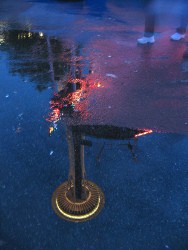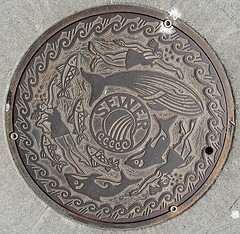 The mess being caused by polluted runoff in the Northwest isn’t letting up, and neither are supporters of a plan to pay for stormwater cleanup.
The mess being caused by polluted runoff in the Northwest isn’t letting up, and neither are supporters of a plan to pay for stormwater cleanup.
Over a single rainy weekend this winter, Seattle Public Utilities got 700 calls about flooding and sent cleanup crews to 332 locations. In Port Angeles, the storm system was so overwhelmed after a December downpour that 15 million gallons of raw sewage and rainwater fouled the city’s shoreline. Officials there recommended the public steer clear of the bay for at least a week due to health concerns.
In a move to mitigate stormwater woes like these, lawmakers in Olympia this week announced the 2011 Clean Water Jobs Act. It’s the third year running that Washington’s legislators have debated a plan to create a dedicated, ongoing funding source to pay for the cleanup and reduction of toxic runoff. Stormwater is created when rain hits roofs, driveways, highways, and landscaped yards, sponging off oil and grease, pesticides, and other filth, dumping it straight into the region’s waterways.
The Clean Water Jobs Act would put a 1 percent fee on petroleum products, pesticides, herbicides, and fertilizers. Other products can be added to the list if the state Department of Ecology decides they’re “significant contributors to the contamination of surface water runoff.” The legislation, SB 5604/HB 1735, is one of the top priorities for the state’s environmental coalition. It also has support from city and county government groups, as well as the labor community.
The environmental community projects the fees could raise approximately $100 million a year to pay for projects to clean up toxic runoff. There’s nothing like it in other Northwest states or provinces. The fees would pay for the construction of stormwater infrastructure, with an emphasis on green solutions called low-impact development. LID focuses on natural ways to control stormwater, such as the construction of rain gardens and swales, green roofs, porous pavement, as well as planting or protecting trees and plants that capture rain drops in their branches or absorb water from the ground.
Here’s how the money would be used:
- $75,000 for the 104 cities and counties regulated under Phase I and II stormwater rules, which, at present, would represent an $8.25 million expenditure*
- $11 million for the state Department of Transportation for stormwater projects
- $3 million for grants provided to organizations that develop stormwater prevention and treatment technologies, and that help businesses and governments test and implement new stormwater technologies
And for the approximately $75 million that remains once those obligations are met:
- 45 percent would go to cities and counties regulated under Phase I and II stormwater rules to prevent or cleanup stormwater pollution; the grants would require a local match
- 45 percent would go to any local governments using low-impact development to address stormwater pollution, except in the case that LID is not technically feasible
- 10 percent would go to top priority stormwater projects, and could be used to fulfill the match requirement
 Approval of the 2011 Clean Water Jobs Act will be a challenge. A similar measure that was limited to a fee on petroleum products failed in 2009 (HB 1614/SB 5518), and a plan to boost a tax on all toxic products to pay for stormwater upgrades lost in 2010 (HB 3181/SB 6851). Both years the proposals had traction in Olympia, but they sank under well-funded opposition from the oil and chemical industries.
Approval of the 2011 Clean Water Jobs Act will be a challenge. A similar measure that was limited to a fee on petroleum products failed in 2009 (HB 1614/SB 5518), and a plan to boost a tax on all toxic products to pay for stormwater upgrades lost in 2010 (HB 3181/SB 6851). Both years the proposals had traction in Olympia, but they sank under well-funded opposition from the oil and chemical industries.
And there’s plenty that the opposition’s not going to like about this version of the legislation. There’s certain to be a fight over the inclusion of aviation fuel in the mix of petroleum products covered by the fee. In the past, home heating oil was excluded from the list, but it’s in this year’s lineup. And the industrial ag community likely won’t be pleased to see a fee on pesticides, herbicides, and fertilizers.
That said, there seems to be an ever increasing awareness of the threats of stormwater runoff and there are LID projects are cropping up around the Northwest—but not nearly enough to match the challenge. Many people appreciate the logic of a funding system like this one in which the “polluter pays” for the damage being caused to the environment and human health through a fee. Perhaps there’s been enough flooding, enough raw sewage spilled, enough oily water puddled to at last put this legislation over the top. We’ll keep you updated.
* Phase I and Phase II stormwater permittees are regulated by the state Department of Ecology. There are six Phase I governments: Seattle, Tacoma, and King, Snohomish, Pierce, and Clark Counties; and there are 104 Phase II cities and counties. The number of Phase II permittees in particular could increase based on the new Census data and as a result of upcoming revisions by the EPA of federal stormwater rules.
Space needle puddle photo from Flickr user shannonkringen and Seattle sewer cover from Flickr user Choconancy1, both used under the Creative Commons license.

Comments are closed.